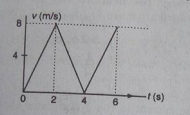If a freely falling body travels in the last second, a distance equal to the distance travelled by it in the first three second, the time of the travel is
6sec
5sec
4sec
3sec
The correct Answer is:B
Step by step video, text & image solution for If a freely falling body travels in the last second, a distance equal to the distance travelled by it in the first three second, the time of the travel is by Physics experts to help you in doubts & scoring excellent marks in Class 11 exams.
Updated on:21/07/2023Topper's Solved these Questions
- MOTION IN ONE DIMENSIONBOOK - ERRORLESS CHAPTER - MOTION IN ONE DIMENSIONEXERCISE - Critical Thinking
19 Videos
- MOTION IN ONE DIMENSIONBOOK - ERRORLESS CHAPTER - MOTION IN ONE DIMENSIONEXERCISE - Graphical Questions
23 Videos
- MOTION IN ONE DIMENSIONBOOK - ERRORLESS CHAPTER - MOTION IN ONE DIMENSIONEXERCISE - Relative Motion
13 Videos
- GRAVITATIONBOOK - ERRORLESS CHAPTER - GRAVITATIONEXERCISE - SET
27 Videos
- MOTION IN TWO DIMENSIONBOOK - ERRORLESS CHAPTER - MOTION IN TWO DIMENSIONEXERCISE - Exercise
319 Videos
Similar Questions
Knowledge Check
The distance travelled by the moving body is :
AThe area between the speed time graph and time axis.BThe area between the speed time graph and speed axisCThe area between the distance time graph and time axisDThe area between the distance time graph and distance axisIf wavelength is equal to the distance travelled by the electron in one second , then :
Aλ=h/pBλ=h/mCλ=√h/pDλ=√h/mIf wavelength is equal to the distance travelled by the electron in one second then
Aλ=h/pBλ=h/mCλ=√h/pDλ=√h/m
A stone falls freely rest. The distance covered by it in the last second is equal to the distance covered by it in the first 2 s. The time taken by the stone to reach the ground is
View SolutionDistance travelled in nth second has the units of
View SolutionA freely falling body travelled x m in nth second. Then distance travelled in n−1th second is
View SolutionA stone falls freely such that the distance covered by it in the last second of its motion is equal to the distance covered by it in the first 5 seconds. It remained in air for :-
View SolutionThe v-t graph for a particle is as shown. The distance travelled in the first seconds is :

View Solution
